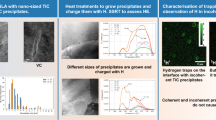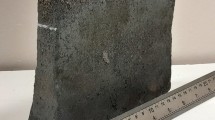Conclusions
-
1.
Increasing the silicon content of Fe−C alloys reduces the thickness of the carbonitride case obtained in low-temperature liquid cyaniding, the phase composition remaining unchanged.
-
2.
The formation of pores in the carbonitride layer at graphite platelets is due to impaired diffusion conditions in the pores surrounding graphite and to the evolution of adsorbed gases.
Similar content being viewed by others
Literature cited
K. Jack, Proc. Roy. Soc., London, No. 195A (1949).
K. Jack, Nature,158, No. 4002 (1946).
Yu. I. Davydov et al., Fiz. i Khim. Obrabotka Metarialov, No. 1 (1969).
Additional information
All-Union Scientific-Research Institute of Textile and Light Machine Construction. Translated from Metallovedenie i Termicheskaya Obrabotka Metallov, No. 4, pp. 61–62, April, 1971.
Rights and permissions
About this article
Cite this article
Belyanin, V.A., Tomas, V.K. Structure of the carbonitride case on gray cast iron after low-temperature cyaniding. Met Sci Heat Treat 13, 332–333 (1971). https://doi.org/10.1007/BF00661352
Issue Date:
DOI: https://doi.org/10.1007/BF00661352




